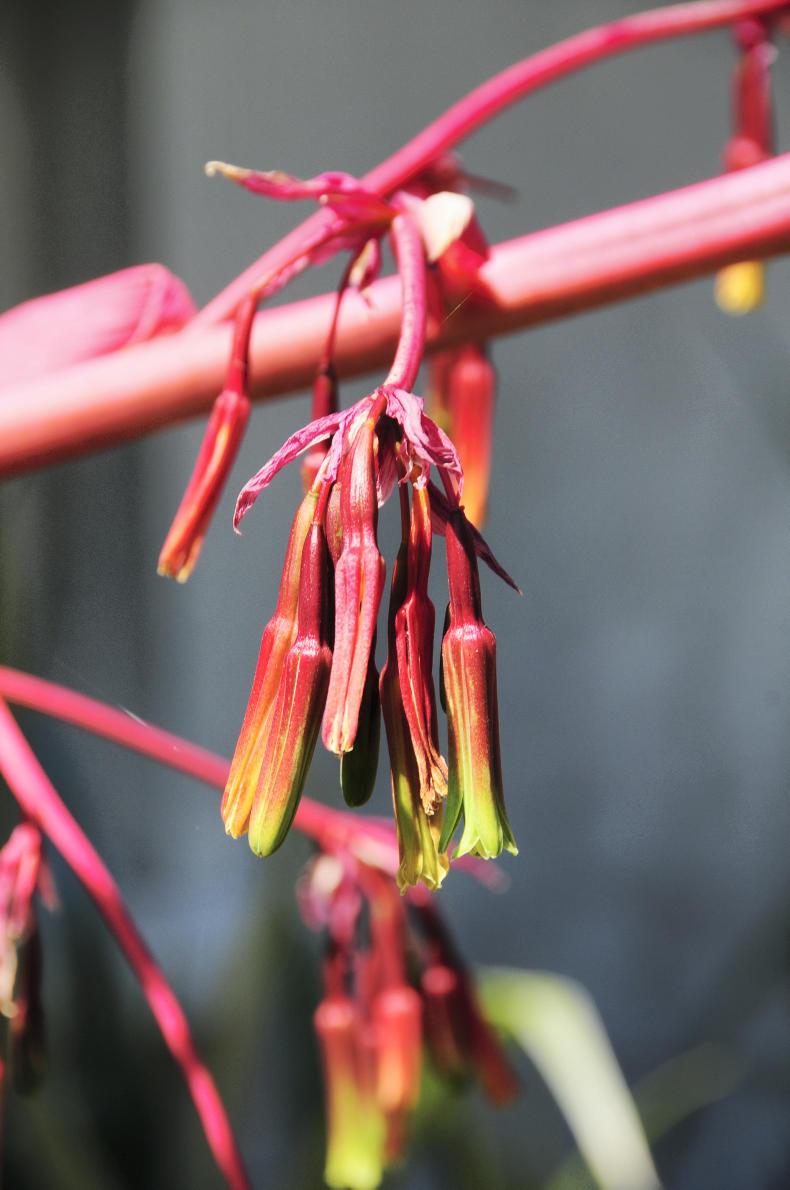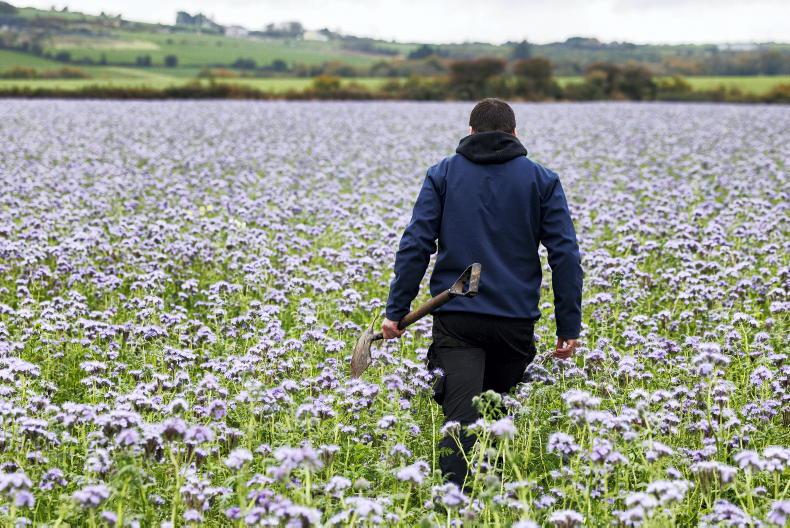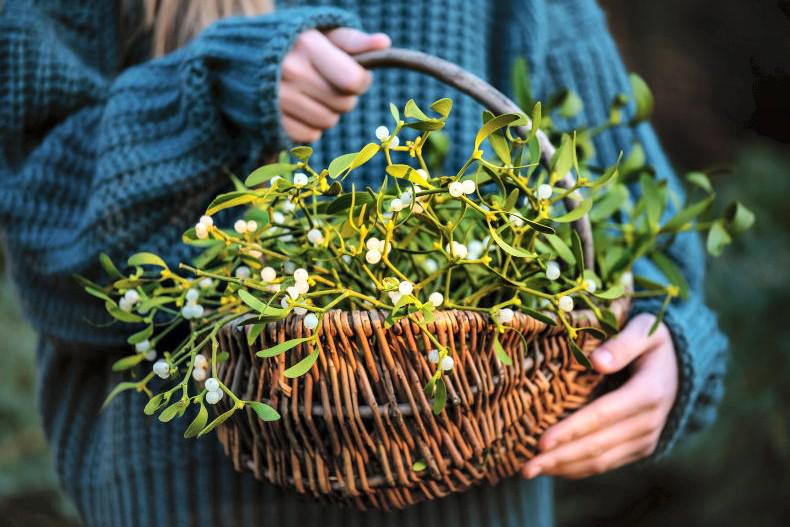If you want something special for planting close to the house, perhaps a border to a paved area, then the Mexican lily, or beschorneria, should be considered. It looks exotic, and it is exotic, in the sense of it being foreign as well as its striking appearance.
Its dramatic foliage looks very well close to a house wall, the pointed, sword-shaped leaves making a good contrast with the smooth surface of a wall that acts as a neutral backdrop.
It also looks great spreading out over the edge of paving slabs, especially natural stone. For the same reason, it also looks wonderful when used near gravel areas, either planted in the gravel or at its edge.
This plant is a close relative of the hardy yuccas that are grown in gardens and make an upright pillar of white or ivory flowers in late summer.
Indoor yucca
Its full botanical name is Beschorneria yuccoides, the second part of the name meaning yucca-like.
It is also related to the indoor yucca, which is widely grown as a house plant with a stem and tuft of broad leaves.
As a house plant, it often gets too tall and, as a result, many specimens have been planted outdoors over the years, but generally they only survive a couple of mild winters, succumbing to frost quite quickly.
This Mexican relative is supposed to be as tender, but it is much tougher and has survived for decades in some gardens.
It is possible that its growing conditions have a very big influence on how it can cope with cold weather, surviving best in very well-drained soil in sunshine. In any case, it is not a wild risk to take in view of the spectacular results.
Big plant
Beschorneria is a big plant that can grow to make a large clump two metres across. The plant is made up of many rosettes of its tall leaves that can reach one metre.
When young, the plant has only one rosette and then others develop from buds at the base and make their own roots.
When rooted, the new rosettes can be detached and grown on to make new plants. The leaves are broad at 7cm or 8cm, sword-shaped, coming to a point.
Unlike yucca, the point is soft and not sharp. The leaves are fully evergreen, of a grey-green or blue-green colour, due to a coating of wax which is protection against drying out in their native land.
Slugs and snails
They are quite fleshy too, another adaptation to counter moisture loss. But coming from an arid land, the fleshy leaves do not have to contend with slugs and snails which are fond of the beschorneria and even shelter amid the leaves from where they can be removed.
Luckily, snails only seem to be a problem with young plants as when the plant gets bigger it simply outgrows the threat, and, possibly frogs are able to find shelter and food amid the rosettes.
Although the leaves are a handsome and all-year-round feature, the flower spikes are the crowning glory.
These appear first in late spring as large green pink buds that extend very fast and eventually make a solid stem that turns quite woody and stiff, often 5cm thick at the base.
Fine branches grow out and the whole spire is decked with hanging flowers at each joint. The stems are red and the tubular flowers dangling from the fine side stems are red and light green.
The flowers produce nectar to attract humming birds as pollinators in their original zone.
They do not seem to set seeds here, insects not achieving pollen transfer. Unlike the yucca, which grow bolt upright, the flower stems of beschorneria tend to flop sideways, even falling to the ground, but this is easily remedied by driving in a stake to hold it up, as it is quite heavy.
A big plant can produce several blooms, which are cut away at the base when finished.
Sweetcorn, courgettes, squashes and runner beans are tender vegetables that must not be planted until the danger of frost has passed, which is now in mild areas and in two or three weeks in cold inland areas. But if the weather is rough and chilly, delay by a few days.

The Mexican lily is an exotic and unusual plant in gardens.
If you sowed seeds in a greenhouse in pots in mid-April, the plants should be about right at the end of May and should be hardened off, outside in a shade spot by day, in by night, for a few weeks or more before being planted. Seeds can still be sown but do not delay.
If you did not sow seeds, then plants can be purchased in garden centres as this is often convenient when only one or two plants, such as pumpkins, are needed, but costly for sweetcorn as more plants, 20 or 30 are required.
Read more
Gerry Daly talks Loder's rhododendrons
Gardening: Blue-purple honeywort
If you want something special for planting close to the house, perhaps a border to a paved area, then the Mexican lily, or beschorneria, should be considered. It looks exotic, and it is exotic, in the sense of it being foreign as well as its striking appearance.
Its dramatic foliage looks very well close to a house wall, the pointed, sword-shaped leaves making a good contrast with the smooth surface of a wall that acts as a neutral backdrop.
It also looks great spreading out over the edge of paving slabs, especially natural stone. For the same reason, it also looks wonderful when used near gravel areas, either planted in the gravel or at its edge.
This plant is a close relative of the hardy yuccas that are grown in gardens and make an upright pillar of white or ivory flowers in late summer.
Indoor yucca
Its full botanical name is Beschorneria yuccoides, the second part of the name meaning yucca-like.
It is also related to the indoor yucca, which is widely grown as a house plant with a stem and tuft of broad leaves.
As a house plant, it often gets too tall and, as a result, many specimens have been planted outdoors over the years, but generally they only survive a couple of mild winters, succumbing to frost quite quickly.
This Mexican relative is supposed to be as tender, but it is much tougher and has survived for decades in some gardens.
It is possible that its growing conditions have a very big influence on how it can cope with cold weather, surviving best in very well-drained soil in sunshine. In any case, it is not a wild risk to take in view of the spectacular results.
Big plant
Beschorneria is a big plant that can grow to make a large clump two metres across. The plant is made up of many rosettes of its tall leaves that can reach one metre.
When young, the plant has only one rosette and then others develop from buds at the base and make their own roots.
When rooted, the new rosettes can be detached and grown on to make new plants. The leaves are broad at 7cm or 8cm, sword-shaped, coming to a point.
Unlike yucca, the point is soft and not sharp. The leaves are fully evergreen, of a grey-green or blue-green colour, due to a coating of wax which is protection against drying out in their native land.
Slugs and snails
They are quite fleshy too, another adaptation to counter moisture loss. But coming from an arid land, the fleshy leaves do not have to contend with slugs and snails which are fond of the beschorneria and even shelter amid the leaves from where they can be removed.
Luckily, snails only seem to be a problem with young plants as when the plant gets bigger it simply outgrows the threat, and, possibly frogs are able to find shelter and food amid the rosettes.
Although the leaves are a handsome and all-year-round feature, the flower spikes are the crowning glory.
These appear first in late spring as large green pink buds that extend very fast and eventually make a solid stem that turns quite woody and stiff, often 5cm thick at the base.
Fine branches grow out and the whole spire is decked with hanging flowers at each joint. The stems are red and the tubular flowers dangling from the fine side stems are red and light green.
The flowers produce nectar to attract humming birds as pollinators in their original zone.
They do not seem to set seeds here, insects not achieving pollen transfer. Unlike the yucca, which grow bolt upright, the flower stems of beschorneria tend to flop sideways, even falling to the ground, but this is easily remedied by driving in a stake to hold it up, as it is quite heavy.
A big plant can produce several blooms, which are cut away at the base when finished.
Sweetcorn, courgettes, squashes and runner beans are tender vegetables that must not be planted until the danger of frost has passed, which is now in mild areas and in two or three weeks in cold inland areas. But if the weather is rough and chilly, delay by a few days.

The Mexican lily is an exotic and unusual plant in gardens.
If you sowed seeds in a greenhouse in pots in mid-April, the plants should be about right at the end of May and should be hardened off, outside in a shade spot by day, in by night, for a few weeks or more before being planted. Seeds can still be sown but do not delay.
If you did not sow seeds, then plants can be purchased in garden centres as this is often convenient when only one or two plants, such as pumpkins, are needed, but costly for sweetcorn as more plants, 20 or 30 are required.
Read more
Gerry Daly talks Loder's rhododendrons
Gardening: Blue-purple honeywort











SHARING OPTIONS